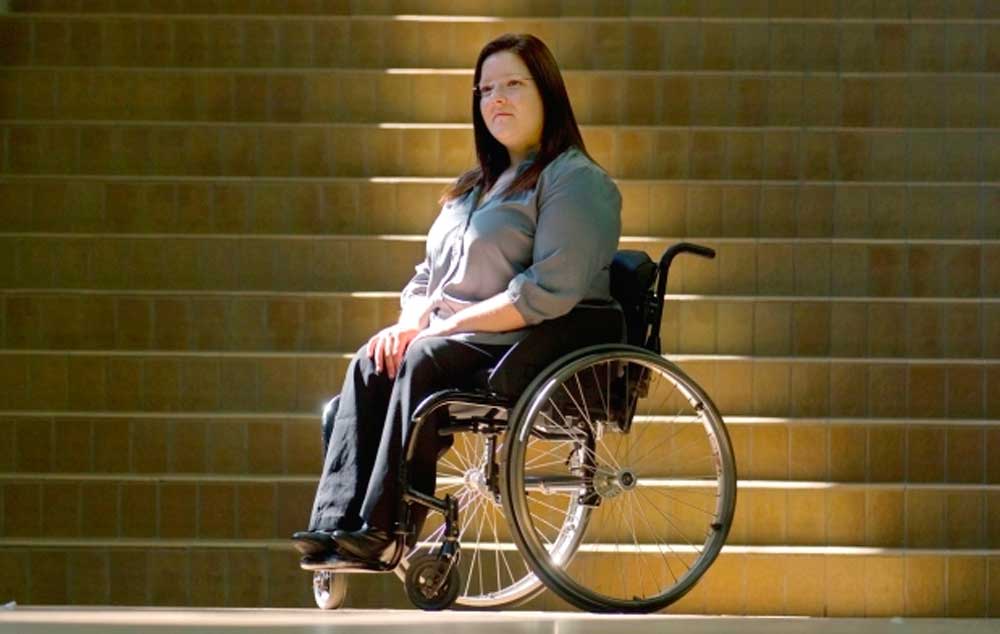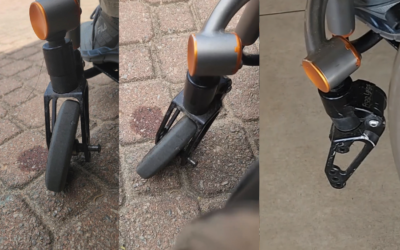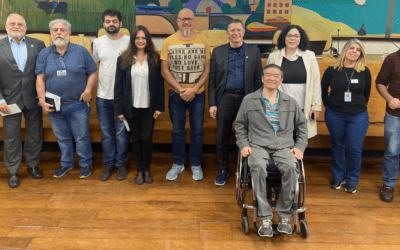
Disabled strive for open doors to accessibility
It started out as a night on the town not unlike the many others Catherine Blanchette-Dallaire had with her friends — until she needed to use the washroom.
It should have been easy enough; it was mid-June and she was on the terrasse of a popular bar on St-Denis St., in the Quartier Latin.
The task would be a lot harder for her than it usually is for most people because on this night, Blanchette-Dallaire was in a wheelchair.
“It was around 12:30 a.m. on a weeknight,” the 31-year-old recalled, “and I had waited and waited until I really needed to go, because I knew it would take me 30 minutes to go to the bathroom.”
Blanchette-Dallaire was more than halfway through the four months of rehabilitation she needed after she broke her ankles in a kayaking accident. She was counting on a nearby movie theatre to use its “fully accessible and really nice” facilities, but it was closed.
“I’m rolling down St-Denis. There are some newer places that are accessible, with a ground-level entrance, but they’re closed at this point. ‘This isn’t happening,’ I thought. ‘I’m a grown woman, I take care of myself. I’m not going to pee my pants.’ So I kept rolling and rolling and a voice inside my head said, ‘Yes, this is happening.’ ”
Desperate, Blanchette-Dallaire used her upper-body strength — which she attributed to an active lifestyle and which, she said, other wheelchair users with a more severe disability would not be able to do — to push herself into a restaurant that had a 15-centimetre step at its entrance.
“I asked: ‘Where is your bathroom? I really need to go!’ He looked at me and said: ‘I’m sorry, but the bathroom is in the basement.’ I said: ‘No, no, you don’t understand. Bring me a bowl or a glass or something. It’s happening right now.’ ”
The restaurant had repurposed a bathroom on the main floor into a storage area. After an employee moved mop buckets and paint cans, Blanchette-Dallaire was able to use the toilet in the cramped space. “The wheelchair just barely fit through the door,” she said.
Embarrassed and frustrated that night, Blanchette-Dallaire returned to the Jacques Viger long-term care hospital on René-Lévesque Blvd. E., where she was recovering, determined to never let something like that happen to her or another wheelchair user again. She called a friend, a long-time wheelchair user, and asked if there was a website that listed businesses and buildings that were accessible. When her friend said that no such directory existed, Blanchette-Dallaire, a website designer, decided she would create one.
“I was in a wheelchair for four months, but there are people who are in that situation their whole lives.”
That fateful night last year led to the creation, one month later, of OnRouleMontreal.ca, a user-generated directory of businesses, shops and buildings that includes detailed information about their accessibility.
Finding something as basic as accessible facilities is one of the many challenges Montrealers with mobility issues face on a daily basis. It is estimated that 15 per cent of Montrealers — or 250,000 people — has a handicap or some form of physical limitation. The figure will continue to grow as 250,000 people living on the island of Montreal are 65 or older.
This helps explain the popularity of Blanchette-Dallaire’s website. By June, OnRouleMontreal.ca received 32,000 visitors in total. She said it’s not just those in wheelchairs seeking the information in her directories. Seniors, people with respiratory issues and parents with young children in strollers also might prefer a store with a ramp rather than stairs at its entrance, and she provides that information.
Organized by neighbourhood or by type of venue, OnRouleMontreal.ca lets users decide if a place is accessible to them. Blanchette-Dallaire analyzes 13 aspects of a venue, including parking, its entrance and bathrooms. Among the questions she answers are: Is the establishment on the ground floor? Are there stairs at the entrance? Is there a ramp? Are the doors wide enough for a wheelchair to pass through? Do they open automatically? Are there accessible bathrooms? Is there a support bar? Is the seat elevated? Is there room under the sink for a wheelchair user to roll up to it and use it? Are there adapted fitting rooms? When paying, can the payment terminal be moved around? Does a restaurant have tables of different heights?
“Depending on the information we provide, the person can decide if this place is accessible for him or her,” Blanchette-Dallaire said.
“Between accessible and fully adapted, there exists an infinite amount of levels of accessibility that are suitable to an infinite amount of types of handicaps and personalities,” she writes on her website.
Blanchette-Dallaire took matters into her hands to try to better the situation for wheelchair users in Montreal. While the situation isn’t worsening, the city still has a long way to go. Governments at the municipal, provincial and federal levels have been throwing money at the problem for years, with mixed results. Some say there is a lack of political will to commit to disabilities causes; others say progress is too slow to come.
In 2011, the city of Montreal and its 19 boroughs adopted a universal accessibility mandate, essentially promising that any new public buildings will be built and designed with accessibility in mind.
But what about the municipal buildings built before 2011? According to Émilie Thuillier, Ahuntsic-Cartierville councillor and member of the city’s executive committee with Projet Montréal responsible for social and community development, 980 of the more than 1,300 municipal buildings in Montreal are open to the public. Since 2009, the city has been pledging $2 million a year for renovations to make them accessible. This year, among the five projects being undertaken with that sum are the St-Michel Arena and the William-Hingston Library in Parc-Extension.
“Some projects get denied because their proposals are not good enough,” Thuillier said. “With the $2 million, we want all-encompassing, exemplary projects that have the most universal accessibility.”
And those projects are on top of what the boroughs plan. In their 2012-14 action plan, boroughs pledged action on about 400 items — though some are incomplete projects from their 2009-11 plans — ranging from bathroom renovations and construction of ramps, to studies and evaluations of parks’ accessibility. In Ahuntsic, Thuillier said, some community gardens are built on an elevation so wheelchair users and other people who cannot bend over are able to use them.
“People have needs and we need to answer them.”
The city consults with dozens of community partners on its projects and it tries to test a strategy before committing to its implementation.
“On paper, it might look OK, but it’s better to test it,” Thuillier said. “The city recognizes that these partners have information that we need and want.”
But Thuillier acknowledged that universal accessibility makes a one-method-fix-all strategy almost impossible.
She noted that when municipalities started putting curb cuts in sidewalks, wheelchair users were happy to no longer have to bump up and down curbs. They had a smooth transition from the curb to the road. People with visual impairments, however, had lost their sensory cue that the sidewalk was ending and could have ended up on the street unknowingly.
Thuillier said installing audible crossing signals — to help the visually impaired — requires the replacement of traffic lights. While 45 such signals were installed across Montreal between 2009 and 2011, there are more than 1,500 traffic lights on the island.
Thuillier also pointed out that designing and building under universal accessibility guidelines saves time and money because there’s no need to replace or adapt facilities afterward. The métro system may be the best example of this.
While the three Laval stations were designed and built in 2007 so they can be accessed by wheelchair users (they have elevators and wider, automatic doors at some entrances), there are only four other stations that have those features: Côte-Vertu became accessible in 2011, Henri-Bourassa and Berri-UQAM in 2010, and Lionel-Groulx in 2009.
Installing an elevator in an existing métro station can cost more than $10 million. Construction in the Champs-de-Mars station started last fall and is slated to cost about $8 million and take two years to complete, while Jean-Talon station will be accessible by 2015, according to the STM.
Stéphanie Gélinas, 28, who lost the use of her legs when she was 18 months old, said she has taken the métro only twice in her life.
“I wanted to see what it was like,” she said. “I left and came back to the same station.”
She took her manual wheelchair on an escalator and said she managed, “but it really wasn’t ideal.”
Gélinas, who lives in Hochelaga-Maisonneuve, laments the lack of an accessible métro station in her area.
“I have no interest in taking the métro if there’s no way for me to get back home.”
Instead, she has relied on the STM’s buses and paratransit service and, more recently, her vehicle.
Because of her more pronounced disability, Deborah Kennard, 59, a quadriplegic who uses a motorized wheelchair, relies exclusively on the STM’s paratransit service.
The two women agreed that a public transportation system catering exclusively to wheelchair users and other disabled people is a move in the right direction.
“When I was a teenager, there wasn’t any adapted transport. Now, there’s a public service,” Kennard said.
But, they said, more work is needed. For example, Gélinas noted that there is only room for one wheelchair user on a city bus at a time. She said she has been met by some frustration by other users because the space for the wheelchair takes up three regular seats. The STM’s newer buses feature lower floors and entrance ramps to make it easier for wheelchair users to get on and off.
The rates for the STM’s paratransit, a door-to-door service for wheelchair users that has to be booked the night before travel, are identical to the STM’s regular fares.
“It’s a necessary service,” Gélinas said. “Without it, there are too many people who would have no means of getting around.”
But she also noted that the service failed to pick her up on several occasions, and said she spent most of some days just waiting for the bus to arrive. Paratransit users must book their return trip at the same time as their pick-up.
“If I have an appointment at the hospital at 2 p.m.,” Gélinas said, “I would book my return trip for 7 p.m. But it’s possible that my appointment ends at 3 p.m. They won’t come back for you early, even if you call. It would be nice if travellers can have some sort of spontaneity. If you decide one morning you want to go somewhere, but you didn’t book your paratransit the day or night before, forget about it.”
Gélinas works for Kéroul, a non-profit organization with a mission to promote accessible tourism and culture. Vacationing wheelchair users are becoming more common, making disabled tourism a growing industry.
She drives to her office in the Olympic Stadium in the vehicle the Société de l’assurance automobile du Québec paid to have modified to suit her needs in 2005 — manual controls to accelerate, brake, use signal and honk, and a mechanical arm that reaches for the wheelchair and locks it in place in the back seat. But getting the vehicle was an 18-month process.
The AMT’s train system isn’t immune to criticism. While the parking lots at many of its stations feature handicapped spots, there is no permanent adapted system in place for wheelchair users to get on or off.
“Finding accessible places can be easy. Getting there, that’s harder,” Gélinas said.
Gélinas said she has adapted over the years and doesn’t lose sleep over her inability to reach inaccessible places. Her one gripe, however, is with Montreal’s underground city, the 32-kilometre network of tunnels, also known as RÉSO, that connects 12 square kilometres of downtown.
“It’s so not accessible,” she said. “It’s horrible.”
While some of the individual properties are accessible, it’s the connections that are problematic. For example, the Eaton Centre and Place Montréal Trust have elevators and those two malls are connected by an accessible ramp, but the underground path from Place Ville Marie to the Eaton Centre is mainly stairs, escalators and manual doors.
André Poulin, CEO of Destination Centre-Ville, the commercial development association of downtown Montreal, said other than a recent report that suggested the underground city needed more accessibility, he wasn’t aware of complaints from wheelchair users. The Montreal Souterrain project was started after the building of Place Ville Marie, more than 50 years ago, when issues of accessibility probably were not in the builders’ conscience, he suggested. The connecting bits, he added, are designed and built by the individual building operators. He said Destination Centre-Ville had no plans — nor the power — to force renovations of the connections.
“It’s such a great alternative in the winter,” Gélinas said, “but in the end, it’s not an option at all.”
McGill University urban planning professor Ahmed El-Geneidy supervised a master’s student’s project that evaluated the accessibility of the underground city. The findings? “It’s very hard for someone with a disability to manoeuvre through it, if not impossible,” El-Geneidy said.
He added that wheelchair users must leave one building and enter another from outside, negating the convenience of the underground tunnels.
“Montreal is going to be facing a big problem soon,” El-Geneidy said, referring to residents entering their senior years and their eventual specialized transportation and accessibility needs.
“It takes a lot of money” to address the issue, he added, and the political will to invest. In the United States, he noted, the Americans with Disabilities Act (ADA) of 1990 brought the issue of universal accessibility to light, requiring all buildings to be designed to allow access for wheelchairs.
“We are generally behind in Montreal,” he said, noting that there is a much higher number of wheelchair users on the streets of other cities.
“Don’t tell me it’s because we have a lower rate of disability. We are not enabling them to get out and do the kinds of activities they want to engage in, that’s the problem.”
Also at McGill, a course offered by the school of occupational therapy places students in a wheelchair for an assignment that challenges them to get from Cours Mont-Royal to Promenades de la Cathédrale using the underground city. The goal is to “learn about architectural accessibility,” said Cynthia Perlman, who teaches the course. There are usually three students to a wheelchair, with one being from occupational therapy and two from architecture.
Perlman said it is usually an eye-opening exercise for students. They are asked to notice how their regular routine may differ as wheelchair users.
At one clothing store, the adapted fitting room was being used as a storage area. Another café claimed to have wheelchair-accessible washrooms, but there were two or three steps to get into the shop instead of a ramp.
“What’s the point?” Perlman asked. “If you’re gonna do something properly, you have to include architects, occupational therapists, urban planners. You need to have an interdisciplinary approach.”
Could a federal bill help accessibility issues in Canadian cities?
The Disabilities Act in the U.S., signed into law in 1990, is a civil-rights act that makes discrimination on the basis of a disability illegal. But it goes one step farther in establishing that the inability of a disabled person to take part in equal enjoyment of a service amounts to discrimination. This means that a wheelchair inaccessible restaurant or hotel violates the ADA.
A Canadian law similar to the ADA is unlikely, having all but disappeared from federal political discourse since it was promised almost eight years ago, said Mary Ann McColl, academic lead at the Canadian Disability Policy Alliance and a professor of rehab therapy at Queen’s University. She said that the ADA and similar legislation in other countries protects against discrimination, something already covered by Canada’s Charter of Rights and Freedoms and provincial human rights charters.
“If we were going to do federal legislation (what we should be doing) is setting national standards for disability support,” McColl said.
There is a federal disability tax credit meant to compensate for extraordinary cost, but it is for a maximum of $7,546. Ontario wheelchair users, depending on their case, may get up to 75 per cent of the cost of their wheelchair back from their provincial government. In Quebec, also depending on the wheelchair user’s situation, a wheelchair may be paid for in full by the Régie de l’assurance maladie du Québec, as in the case of Gélinas, who was the victim of a medical error during surgery.
The Quebec government also regulates the price of certain wheelchair models, but Patrick Zeidan, an administrator at the André Viger wheelchair manufacturing company, said a custom mechanical wheelchair can cost up to $6,500.
“Like our health care, we can expect some degree of similarity, in terms of the health care we receive” from province to province, McColl said. “That harmonization of disability policy would be enormously helpful.”
It’s recommended users replace their wheelchair every five to eight years. Kennard has had hers, which cost $12,000, for five years and is planning on keeping it as long as she can.
“It’s very complicated to replace” because of the detailed specifications she needs, she said. “It’s adapted to me.”
Kennard is also on social assistance and would not be eligible for the federal tax credit available for some wheelchair purchases.
With building codes that require accessibility in Quebec only applied to new construction, and no substantial financial incentive from the city for building owners and businesses to improve accessibility, Blanchette-Dallaire hopes that her website will entice people to recognize the advantage of improving access.
“Only about 15 per cent of private businesses are accessible,” she said. “Of those, only about two per cent are fully accessible and meet every criterion for accessibility.”
“There’s a strong economic potential if businesses will just reach for it,” Blanchette-Dallaire said. “Wheelchair users have such a hard time finding accessible places that they will come back.”
Her directory includes information on more than 240 businesses in Montreal, and she has just expanded to include some in Laval, with plans to expand to other cities in Quebec soon.
Blanchette-Dallaire also started a housing directory which will list wheelchair-friendly apartments and houses for rent or sale.
She had two dreams for her website. The first was to create a community wheelchair users can find solace in, and have members help each other. With more than 32,000 visitors and close to 1,000 followers on social media, she is well on her way to realizing that goal. The second is more complex:
“I want to try to make disabled people proud of themselves. Nothing is simple; they have to have a plan B, C, D, Z! They have a strength of character that a lot people don’t have. They’re incredibly intelligent because they are constantly adapting to challenges.”
Source: The Gazette
Compartilhe
Use os ícones flutuantes na borda lateral esquerda desta página
Siga-nos!
Envolva-se em nosso conteúdo, seus comentários são bem-vindos!
Artigos relacionados
Rodinha dianteira quebrada. Como lidar com um pronto socorro.
Rodinha dianteira quebrada. Imprevistos podem acontecer a qualquer hora em qualquer lugar, por isso o mais importante é saber lidar com eles.
Turismo acessível na política. Comissão do Turismo destaca a importância da acessibilidade.
Turismo acessível na política da Câmara Municipal de SP. Comissão do Turismo destaca a importância da acessibilidade para as PcD.
Teleton AACD. A pessoa com deficiência como protagonista.
Teleton AACD. A pessoa com deficiência como protagonista. Uma iniciativa internacional abraçada pelo SBT no Brasil.






0 comentários